Analysis of Gear System Dynamics Based on Thermal Elastohydrodynamic Lubrication Effects
Abstract
1. Introduction
2. TEHL Model of Gear Line Contact
2.1. Geometric Model
2.2. Basic Equations for TEHL
- (1)
- Reynolds Equationwhere p represents oil film pressure, h denotes oil film thickness, ρ stands for the film-thickness-averaged oil film density, η indicates the film-thickness-averaged lubricant viscosity and ue denotes the entrainment speed.Boundary conditions:where xin denotes the coordinate of the inlet region, and xout denotes the coordinate of the outlet region.
- (2)
- Film Thickness EquationThe film thickness equation for TEHL in gear line contact is as follows:where h0 denotes the central film thickness when the contacting bodies have not undergone elastic deformation, R denotes the effective radius of curvature, given by the following: .
- (3)
- Viscosity–Pressure–Temperature Equationwhere η represents the viscosity at pressure p and temperature T. η0 denotes the ambient viscosity, T0 denotes the ambient temperature, and T represents the oil film temperature.
- (4)
- Density–Pressure–Temperature Equationwhere ρ represents the density at pressure p and temperature T, ρ0 denotes the ambient density, and D represents the density–temperature coefficient.
- (5)
- Load Balance Equationwhere w represents the unit length load.
- (6)
- Energy EquationIn gear lubrication processes, the oil film temperature field can be determined through the energy equation and temperature conditions at the interfaces of the pinion and gear. The energy equation in line contact TEHL is expressed as follows:where z represents the coordinate in the film thickness direction, cp denotes the specific heat capacity of the fluid, k represents the thermal conductivity of the fluid, u denotes the fluid flow velocity in the x direction, and ω represents the fluid flow velocity in the z direction.Boundary conditions:where ρ1 and ρ2 represent the density of the pinion and gear, respectively, c1 and c2 represent the specific heat capacity of the pinion and gear, respectively, k1 and k2 represent the thermal conductivity of the pinion and gear, respectively, and u1 and u2 represent the tangential velocity along the x axis at the surfaces of the pinion and gear, respectively.The presence of the velocity component in the film-thickness direction in the energy equation introduces certain difficulties in solving the equation. This component can be eliminated using the fluid continuity equation. To solve the energy equation more efficiently, the velocity field and continuity equation required in the solution process are provided below. The specific steps for normalization and discretization of the equations can be found in Ref. [38].
- (7)
- Calculation of the Velocity FieldIn line contact, assuming the viscosity of the lubricant varies along the film thickness direction, the velocity in the x direction can be expressed as follows:The velocity gradient of the lubricant film in the film thickness direction can be expressed as follows:
- (8)
- Continuity EquationIn elastohydrodynamic lubrication problems, assuming the density of the lubricant does not vary with time, the continuity equation for line contact elastohydrodynamic lubrication can be derived as follows:After discretizing and normalizing the above equation, numerical methods are employed for solving it.
2.3. Numerical Methods
2.4. Comparison Between Empirical Formulas and Numerical Solutions
3. Analysis of Gear Stiffness Characteristics Based on TEHL
3.1. Calculation of Mesh Stiffness of Gears
| Ai | Bi | Ci | Di | Ei | Fi | |
|---|---|---|---|---|---|---|
| L*(hfi,θf) | −5.574 × 10−5 | −1.9986 × 10−3 | −2.0315 × 10−4 | 4.7702 × 10−3 | 0.0271 | 6.8045 |
| M*(hfi,θf) | 60.111 × 10−5 | 28.100 × 10−3 | −83.431 × 10−4 | −9.9256 × 10−3 | 0.1624 | 0.9086 |
| P*(hfi,θf) | −50.952 × 10−5 | 185.50 × 10−3 | 0.0853 × 10−4 | 53.3 × 10−3 | 0.2895 | 0.9236 |
| Q*(hfi,θf) | −6.2042 × 10−5 | 9.0889 × 10−3 | −4.0964 × 10−4 | 7.8297 × 10−3 | −0.1472 | 0.6904 |
3.2. A Normal Oil Film Stiffness Model Based on TEHL
3.3. A Comprehensive Stiffness Model of Gears Based on TEHL
4. Analysis of Gear Dynamic Characteristics Based on TEHL
4.1. Dynamic Model of the Gear Transmission System
4.2. Formulation of the Dynamic Differential Equations
4.3. Dynamic Response Analysis of Gear Systems
4.3.1. Effect of Lubrication on the Dynamic Response Characteristics of the Gear System
4.3.2. Influence of Speed on the Dynamic Response Characteristics of Gear System Under Lubrication Condition
4.3.3. Influence of Load on the Dynamic Response Characteristics of Gear System Under Lubrication Condition
4.3.4. Influence of Initial Viscosity on the Dynamic Response Characteristics of Gear System Under Lubrication Condition
5. Conclusions
- (1)
- Taking into account the TEHL effect, it has been observed that the dynamic transmission error along the gear meshing line exhibits an increase, particularly within the double-tooth engagement region. Compared to the model without consideration of oil-film stiffness, the amplitudes of dynamic transmission error, vibration velocity, and dynamic meshing force all exhibit a certain degree of reduction when the oil film stiffness is included. When the oil film stiffness effects are incorporated into the analysis, the vibrational characteristics of the system become significantly more pronounced, necessitating their consideration in dynamic analyses.
- (2)
- As the rotational speed escalates, there is a corresponding increase in the amplitudes of dynamic transmission error, vibration velocity, and dynamic meshing force, which subsequently diminishes the stability of the gear transmission system.
- (3)
- As the load increases, there is a corresponding rise in the amplitudes of dynamic transmission error, vibration velocity, and dynamic meshing force, which subsequently diminishes the stability of the gear transmission system. The dynamic meshing force experiences a significant escalation in response to elevated external loads. In the context of heavily loaded gear systems, it is essential to account for the effects of TEHL on the dynamic characteristics.
- (4)
- An increase in the initial viscosity of lubricating oil is associated with a reduction in the fluctuations of the dynamic transmission error, while the variations in vibration velocity and dynamic meshing force remain minimal. Consequently, under these circumstances, a judicious increase in the initial viscosity of the lubricating oil can improve the transmission stability of the gear system.
Author Contributions
Funding
Data Availability Statement
Conflicts of Interest
Nomenclature
| B | gear width | rb1,rb2 | base circle radii of pinion and gear |
| b | half-width of Hertzian contact area | T | oil film temperature |
| c1,c2 | specific heat capacity of pinion and gear | T0 | ambient temperature |
| cp | specific heat capacity of lubricant | Tp,Tg | input torque and output torque |
| ct | meshing damping | ue | entrainment speed |
| D | density–temperature coefficient | u | fluid flow velocity in the x direction |
| E1,E2 | elastic modulus of pinion and gear | u1,u2 | tangential velocity of the pinion and gear |
| E | comprehensive elastic modulus | U | dimensionless entrainment speed |
| F | meshing force | vDTE | vibration velocity |
| Fa,Fb | components of meshing force | w | load per unit length |
| Fd | dynamic meshing force | W | dimensionless load |
| G | material parameter | Δx | grid length |
| h | oil film thickness | z1,z2 | number of teeth of pinion and gear |
| h0 | central film thickness | ω | fluid flow velocity in the z direction |
| hmin | minimum oil film thickness | η | dynamic viscosity of lubricant |
| I1,I2 | moment of inertia of pinion and gear | η0 | ambient viscosity |
| k | thermal conductivity of lubricant | ν1,ν2 | ambient viscosity |
| k1,k2 | thermal conductivity of pinion and gear | ρ | oil film density |
| Koi | single node oil film stiffness | ρ0 | ambient oil density |
| koil | contact area oil film stiffness | ρ1,ρ2 | density of pinion and gear |
| Km | gear meshing stiffness | ζ | meshing damping ratio |
| Kc | normal comprehensive stiffness | ||
| m | gear module | ||
| m1,m2 | mass of pinion and gear | ||
| me | equivalent mass of gear system | ||
| p | oil film pressure | ||
| pH | maximum Hertzian contact pressure | ||
| R1,R2 | curvature radii of pinion and gear | ||
| R | equivalent radius of curvature | ||
| r1,r2 | pitch circle radii of pinion and gear |
References
- Marian, M.; Bartz, M.; Wartzack, S.; Rosenkranz, A. Non-Dimensional Groups, Film Thickness Equations and Correction Factors for Elastohydrodynamic Lubrication: A Review. Lubricants 2020, 8, 95. [Google Scholar] [CrossRef]
- Lu, R.; Tang, W.; Huang, Q.; Xie, J. An Improved Load Distribution Model for Gear Transmission in Thermal Elastohydrodynamic Lubrication. Lubricants 2023, 11, 177. [Google Scholar] [CrossRef]
- Dong, G. Damping Characteristics of Thermal Elastohydrodynamic Lubricated Point Contacts. J. Braz. Soc. Mech. Sci. Eng. 2021, 43, 137. [Google Scholar] [CrossRef]
- Zhou, Y.; Zhu, C.; Liu, H. A Micropitting Study Considering Rough Sliding and Mild Wear. Coatings 2019, 9, 639. [Google Scholar] [CrossRef]
- Fang, C.; Zhu, A.; Zhou, W.; Peng, Y.; Meng, X. On the Stiffness and Damping Characteristics of Line Contacts under Transient Elastohydrodynamic Lubrication. Lubricants 2022, 10, 73. [Google Scholar] [CrossRef]
- Habchi, W. Coupling Strategies for Finite Element Modeling of Thermal Elastohydrodynamic Lubrication Problems. J. Tribol. 2017, 139, 041501. [Google Scholar] [CrossRef]
- Amine, G.; Fillot, N.; Philippon, D.; Devaux, N.; Dufils, J.; Macron, E. Dual Experimental-Numerical Study of Oil Film Thickness and Friction in a Wide Elliptical TEHL Contact: From Pure Rolling to Opposite Sliding. Tribol. Int. 2023, 184, 108466. [Google Scholar] [CrossRef]
- Havaej, P.; Degroote, J.; Fauconnier, D. A Quantitative Analysis of Double-Sided Surface Waviness on TEHL Line Contacts. Tribol. Int. 2023, 183, 108389. [Google Scholar] [CrossRef]
- Huang, X.; Yang, B.; Wang, Y. A Nano-Lubrication Solution for High-Speed Heavy-Loaded Spur Gears and Stiffness Modelling. Appl. Math. Model. 2019, 72, 623–649. [Google Scholar] [CrossRef]
- Hultqvist, T.; Vrcek, A.; Marklund, P.; Prakash, B.; Larsson, R. Transient Analysis of Surface Roughness Features in Thermal Elastohydrodynamic Contacts. Tribol. Int. 2020, 141, 105915. [Google Scholar] [CrossRef]
- Zhao, Z.; Yang, Y.; Han, H.; Ma, H.; Wang, H.; Li, Z. Meshing Characteristics of Spur Gears Considering Three-Dimensional Fractal Rough Surface under Elastohydrodynamic Lubrication. Machines 2022, 10, 705. [Google Scholar] [CrossRef]
- Li, S.; Kahraman, A. A Scuffing Model for Spur Gear Contacts. Mech. Mach. Theory 2021, 156, 104161. [Google Scholar] [CrossRef]
- Ziegltrum, A.; Lohner, T.; Stahl, K. TEHL Simulation on the Influence of Lubricants on Load-Dependent Gear Losses. Tribol. Int. 2017, 113, 252–261. [Google Scholar] [CrossRef]
- Natali, C.; Battarra, M.; Dalpiaz, G.; Mucchi, E. A Critical Review on FE-Based Methods for Mesh Stiffness Estimation in Spur Gears. Mech. Mach. Theory 2021, 161, 104319. [Google Scholar] [CrossRef]
- Xu, L.; Luo, Y.; Hu, R. A Novel Method of Modelling Contact Dynamics for Spur Gear Transmission. Mech. Mach. Theory 2024, 203, 105793. [Google Scholar] [CrossRef]
- Kumar, V.; Kumar, A.; Kumar, S.; Sarangi, S. TVMS Calculation and Dynamic Analysis of Carburized Spur Gear Pair. Mech. Syst. Signal Process. 2022, 166, 108436. [Google Scholar] [CrossRef]
- Xie, C.; Shu, X. A New Mesh Stiffness Model for Modified Spur Gears with Coupling Tooth and Body Flexibility Effects. Appl. Math. Model. 2021, 91, 1194–1210. [Google Scholar] [CrossRef]
- Wang, J.; Yang, J.; Lin, Y.; He, Y. Analytical Investigation of Profile Shifts on the Mesh Stiffness and Dynamic Characteristics of Spur Gears. Mech. Mach. Theory 2022, 167, 104529. [Google Scholar] [CrossRef]
- Guan, X.; Tang, J.; Hu, Z.; Wang, Q.; Kong, X. A New Dynamic Model of Light-Weight Spur Gear Transmission System Considering the Elasticity of the Shaft and Gear Body. Mech. Mach. Theory 2022, 170, 104689. [Google Scholar] [CrossRef]
- Kong, X.; Tang, J.; Hu, Z.; Ding, H.; Wang, Z.; Wang, Q. Dynamic Modeling and Vibration Analysis of Spur Gear System Considering Thin-Walled Gear and Hollow Shaft. Mech. Mach. Theory 2023, 181, 105197. [Google Scholar] [CrossRef]
- Wei, S.; Chu, F.-L.; Ding, H.; Chen, L.-Q. Dynamic Analysis of Uncertain Spur Gear Systems. Mech. Syst. Signal Process. 2021, 150, 107280. [Google Scholar] [CrossRef]
- Zhao, Z.; Han, H.; Wang, P.; Ma, H.; Zhang, S.; Yang, Y. An Improved Model for Meshing Characteristics Analysis of Spur Gears Considering Fractal Surface Contact and Friction. Mech. Mach. Theory 2021, 158, 104219. [Google Scholar] [CrossRef]
- Huangfu, Y.; Chen, K.; Ma, H.; Li, X.; Han, H.; Zhao, Z. Meshing and Dynamic Characteristics Analysis of Spalled Gear Systems: A Theoretical and Experimental Study. Mech. Syst. Signal Process. 2020, 139, 106640. [Google Scholar] [CrossRef]
- Chen, K.; Huangfu, Y.; Ma, H.; Xu, Z.; Li, X.; Wen, B. Calculation of Mesh Stiffness of Spur Gears Considering Complex Foundation Types and Crack Propagation Paths. Mech. Syst. Signal Process. 2019, 130, 273–292. [Google Scholar] [CrossRef]
- Chen, Z.; Ning, J.; Wang, K.; Zhai, W. An Improved Dynamic Model of Spur Gear Transmission Considering Coupling Effect between Gear Neighboring Teeth. Nonlinear Dyn. 2021, 106, 339–357. [Google Scholar] [CrossRef]
- Kalay, O.C.; Doğan, O.; Yılmaz, T.G.; Yüce, C.; Karpat, F. A Comparative Experimental Study on the Impact Strength of Standard and Asymmetric Involute Spur Gears. Measurement 2021, 172, 108950. [Google Scholar] [CrossRef]
- Gao, P.; Liu, H.; Yan, P.; Xie, Y.; Xiang, C.; Wang, C. Research on Application of Dynamic Optimization Modification for an Involute Spur Gear in a Fixed-Shaft Gear Transmission System. Mech. Syst. Signal Process. 2022, 181, 109530. [Google Scholar] [CrossRef]
- Xiao, Z.; Zhou, C.; Chen, S.; Li, Z. Effects of Oil Film Stiffness and Damping on Spur Gear Dynamics. Nonlinear Dyn. 2019, 96, 145–159. [Google Scholar] [CrossRef]
- Zhou, C.; Xiao, Z.; Chen, S.; Han, X. Normal and Tangential Oil Film Stiffness of Modified Spur Gear with Non-Newtonian Elastohydrodynamic Lubrication. Tribol. Int. 2017, 109, 319–327. [Google Scholar] [CrossRef]
- Li, Z.; Zhu, C.; Liu, H.; Gu, Z. Mesh Stiffness and Nonlinear Dynamic Response of a Spur Gear Pair Considering Tribo-Dynamic Effect. Mech. Mach. Theory 2020, 153, 103989. [Google Scholar] [CrossRef]
- Ouyang, T.; Huang, G.; Chen, J.; Gao, B.; Chen, N. Investigation of Lubricating and Dynamic Performances for High-Speed Spur Gear Based on Tribo-Dynamic theory. Tribol. Int. 2019, 136, 421–431. [Google Scholar] [CrossRef]
- Zhou, C.; Xiao, Z. Stiffness and Damping Models for the Oil Film in Line Contact Elastohydrodynamic Lubrication and Applications in the Gear Drive. Appl. Math. Model. 2018, 61, 634–649. [Google Scholar] [CrossRef]
- Zhou, C.; Xing, M.; Hu, B. A Mesh Stiffness Model with the Asperity Contact for Spur Gear in Mixed Elastohydrodynamic Lubrication. J. Braz. Soc. Mech. Sci. Eng. 2022, 44, 466. [Google Scholar] [CrossRef]
- Yang, X.; Tofighi-Niaki, E.; Zuo, M.J.; Tian, Z.; Safizadeh, M.S.; Qin, D. Analysis of Spur Gearbox Dynamics Considering Tooth Lubrication and Tooth Crack Severity Progression. Tribol. Int. 2023, 178, 108027. [Google Scholar] [CrossRef]
- Jian, G.; Wang, Y.; Zhang, P.; Xie, Y.; Zhao, J. Analysis of Lubricating Performance for Involute Spur Gear under Vibration. Lubr. Sci. 2020, 32, 344–357. [Google Scholar] [CrossRef]
- Liguori, A.; Armentani, E.; Bertocco, A.; Formato, A.; Pellegrino, A.; Villecco, F. Noise Reduction in Spur Gear Systems. Entropy 2020, 22, 1306. [Google Scholar] [CrossRef]
- Yang, P.; Wen, S. A Generalized Reynolds Equation for Non-Newtonian Thermal Elastohydrodynamic Lubrication. J. Tribol. 1990, 112, 631–636. [Google Scholar] [CrossRef]
- Huang, P. Numerical Calculation of Elastohydrodynamic Lubrication: Methods and Programs; John Wiley & Sons: Hoboken, NJ, USA, 2015; ISBN 1-118-92099-6. [Google Scholar]
- Huang, P. Numerical Calculation Methods of Elastohydrodynamic Lubrication; Tsinghua University Press: Beijing, China, 2013. [Google Scholar]
- Dowson, D. Elastohydrodynamics. Proc. Inst. Mech. Eng. Conf. Proc. 1967, 182, 151–167. [Google Scholar] [CrossRef]
- Yang, P.; Wen, S. A New Solution Method for Line Contact Elastohydrodynamic Lubrication Problems and a More Accurate Film Thickness Formula; Tsinghua University Science Reports; Tsinghua University: Beijing, China, 1988. [Google Scholar]
- Sainsot, P.; Velex, P.; Duverger, O. Contribution of Gear Body to Tooth Deflections—A New Bidimensional Analytical Formula. J. Mech. Des. 2004, 126, 748–752. [Google Scholar] [CrossRef]
- Cao, X.; Zhou, Y.; Deng, X.; Zhang, H. Relationship Among Transmission Error, Contact Ratio and Noise of Spiral Bevel Gears. J. Henan Univ. Sci. Technol. Nat. Sci. 2003, 24, 16–19. [Google Scholar] [CrossRef]

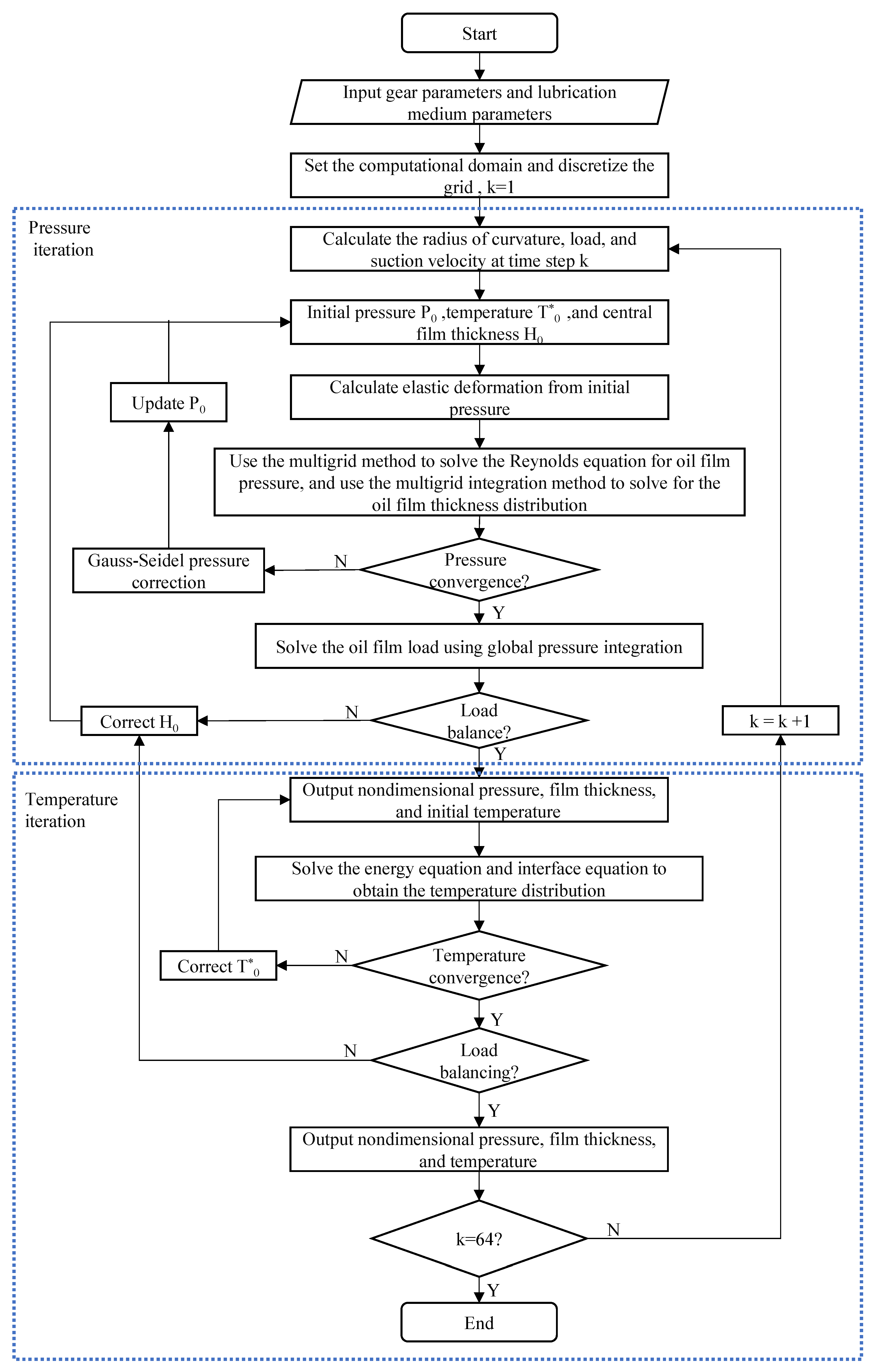
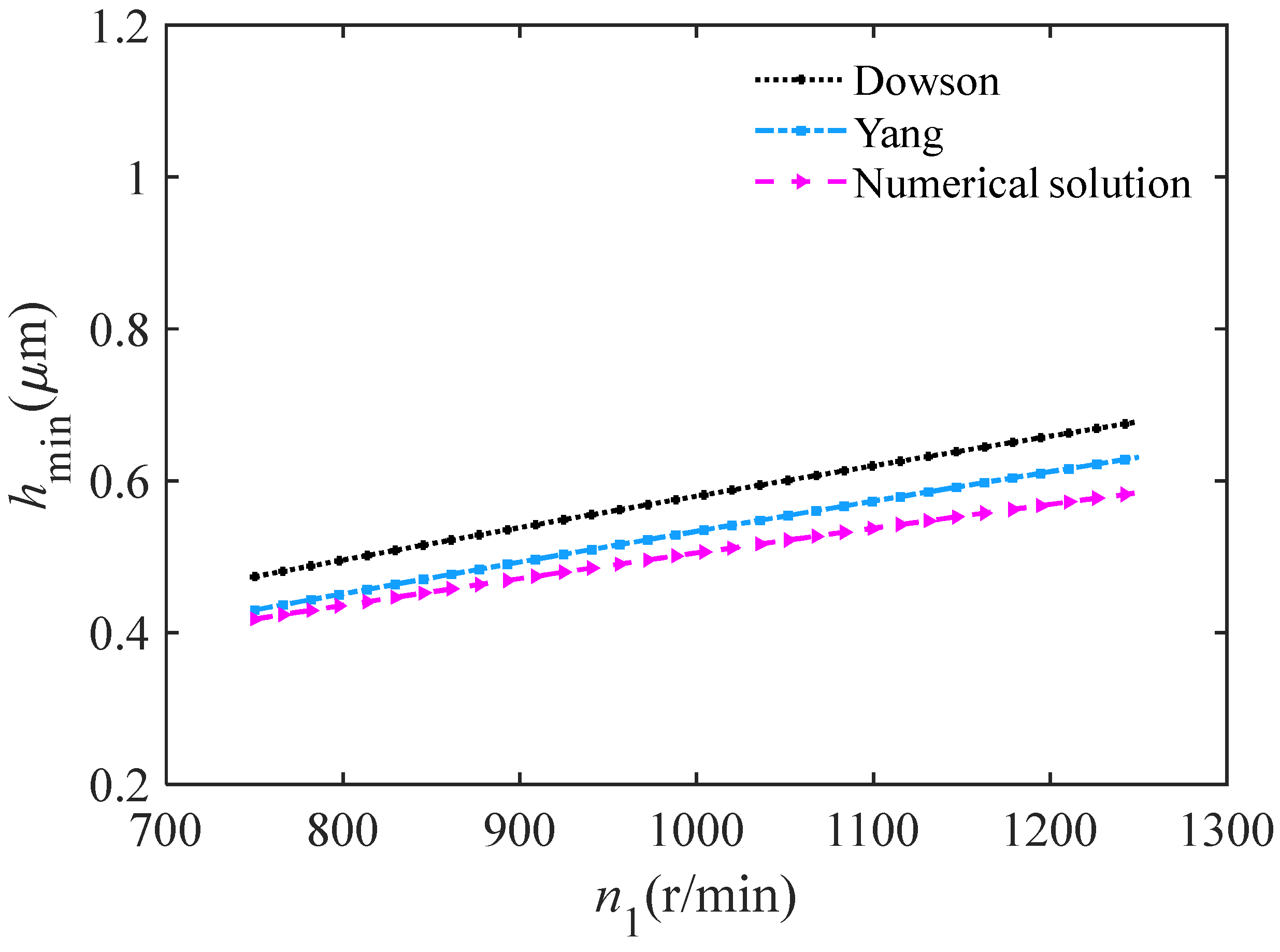
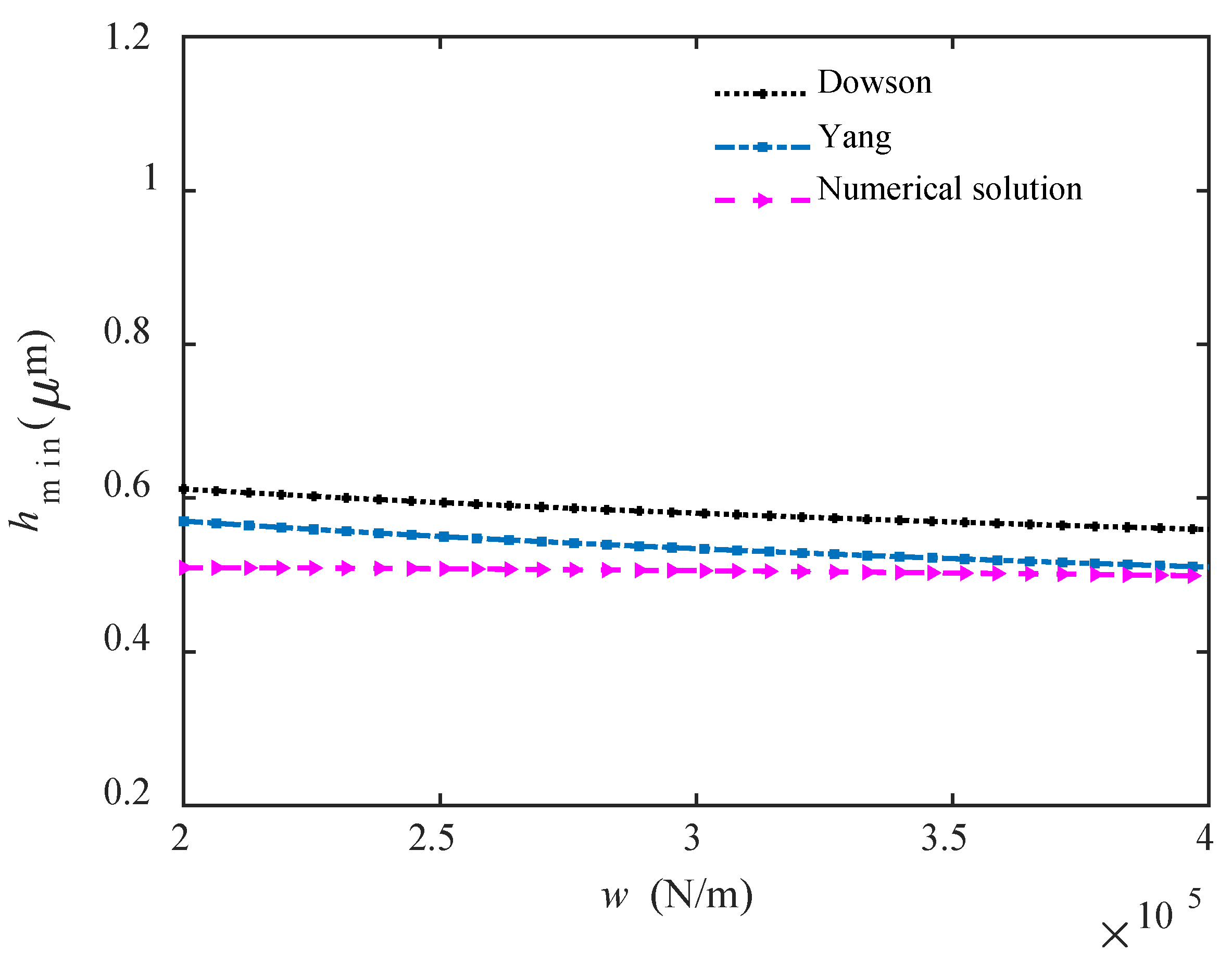
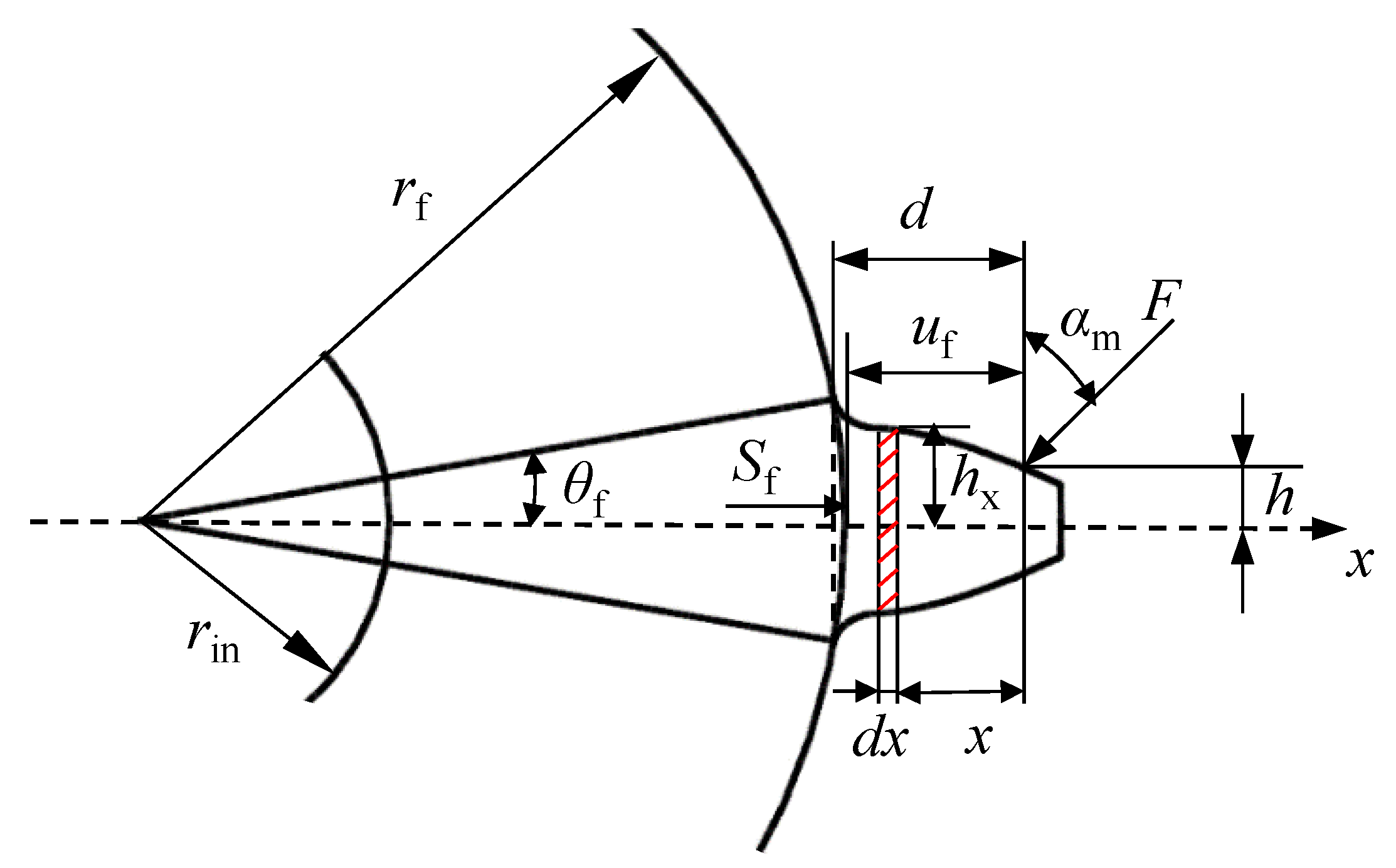
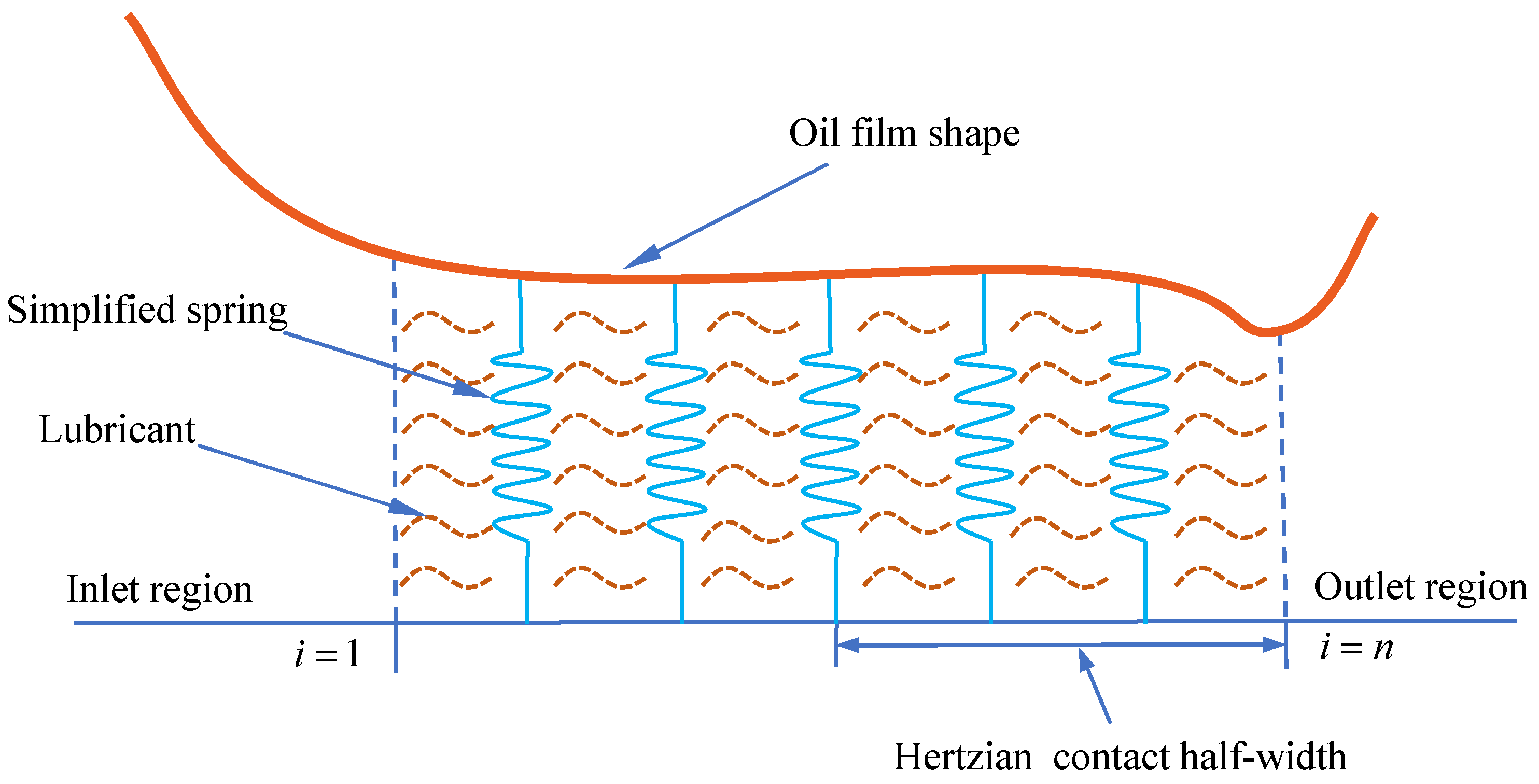
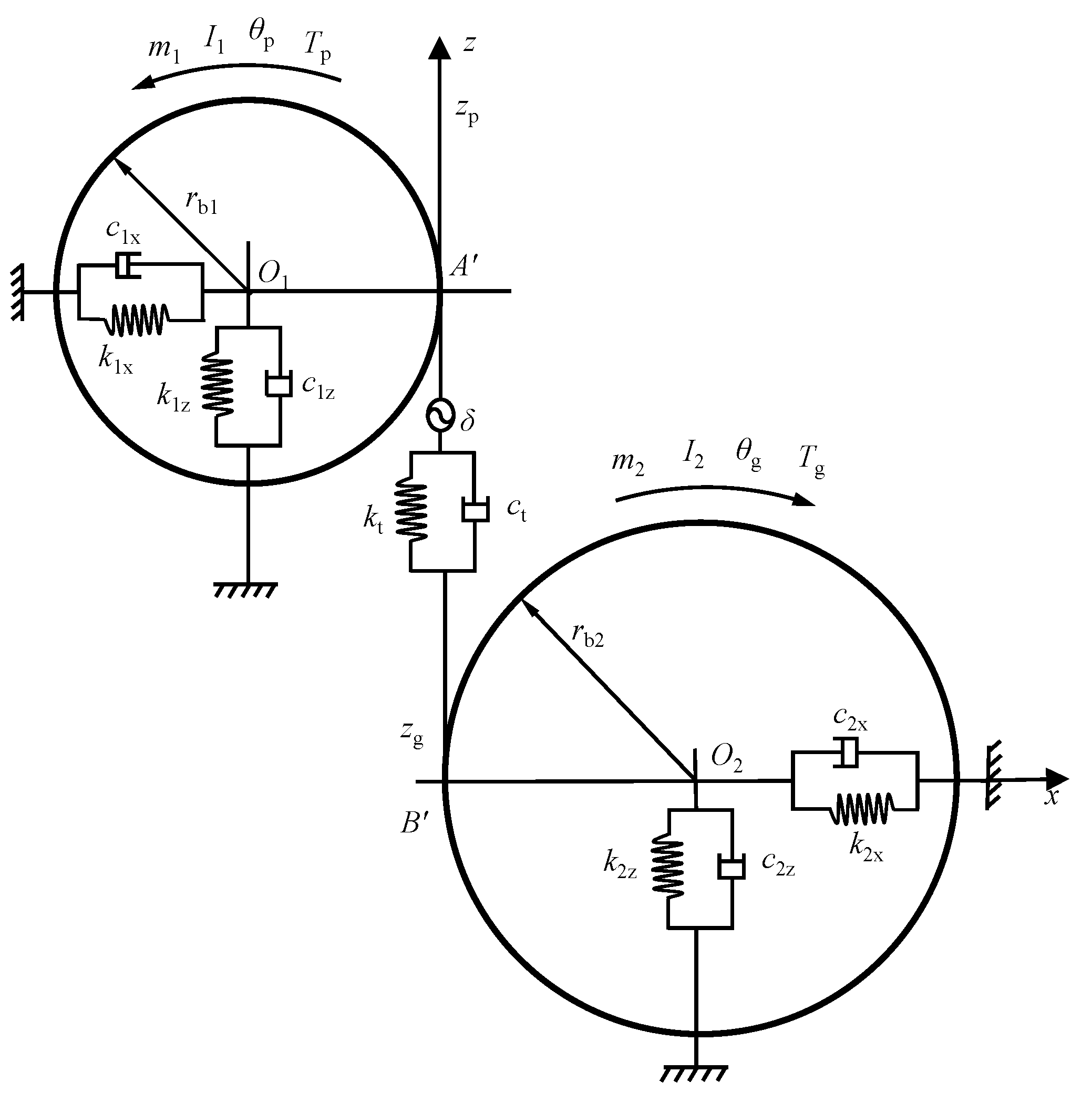
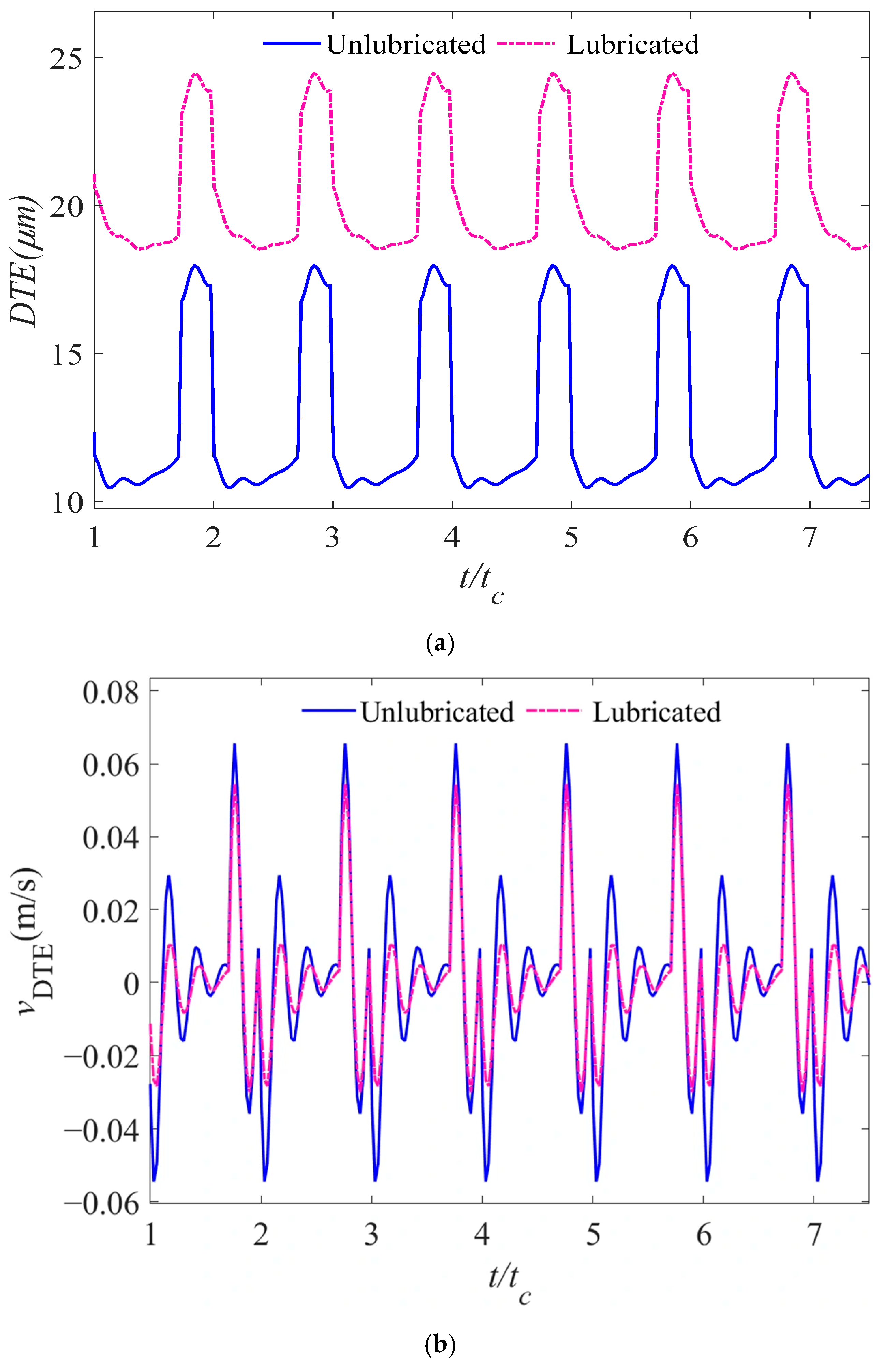
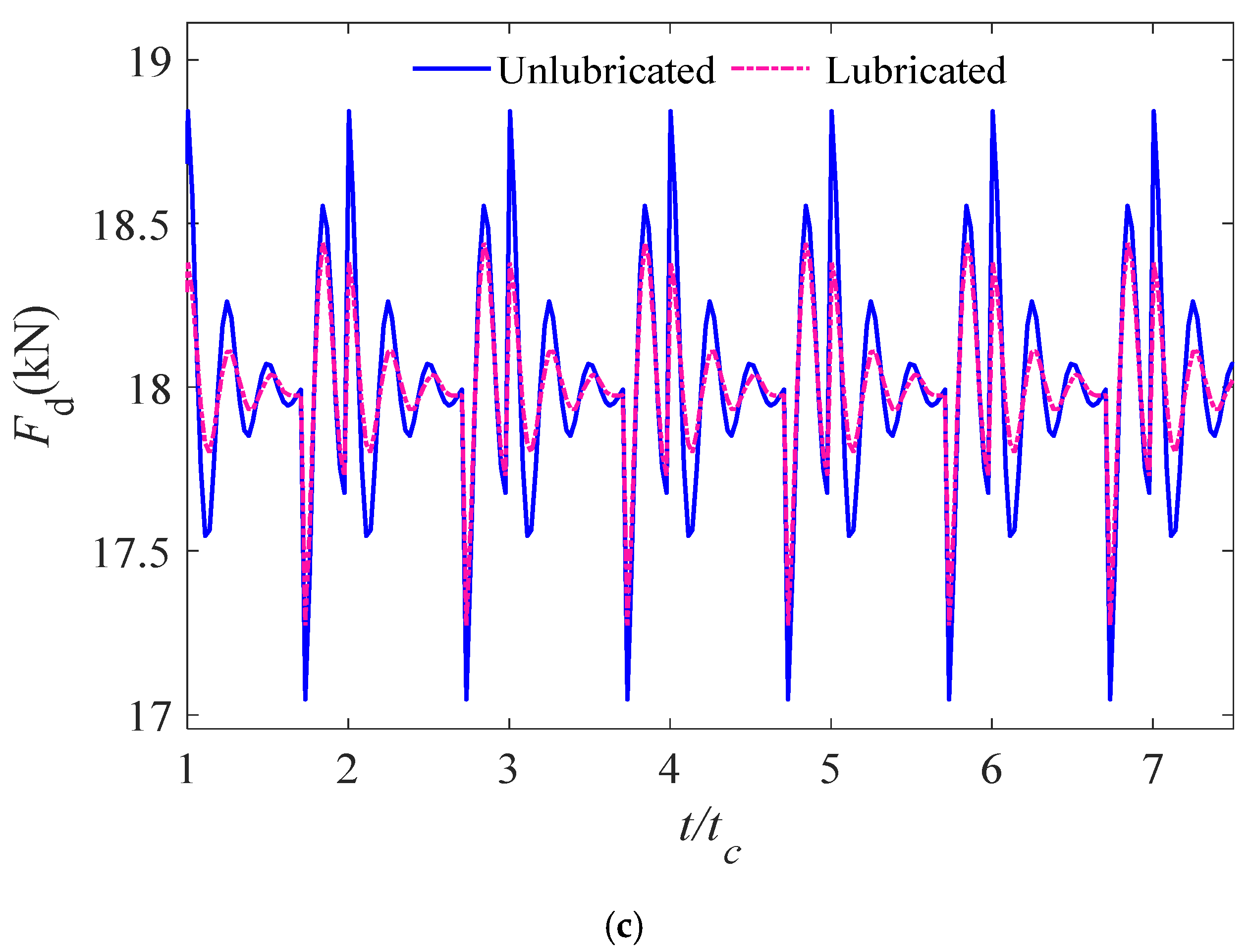
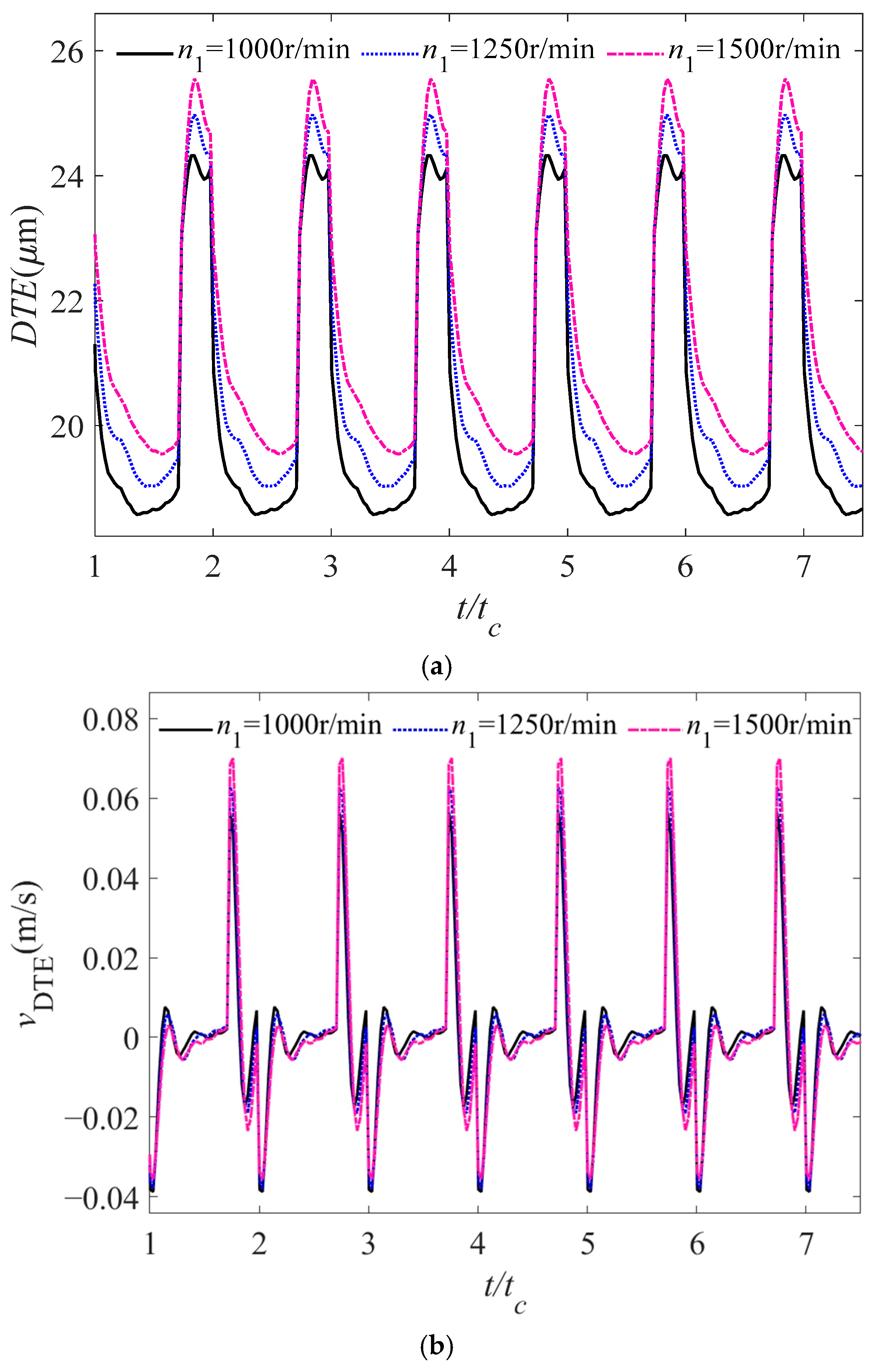
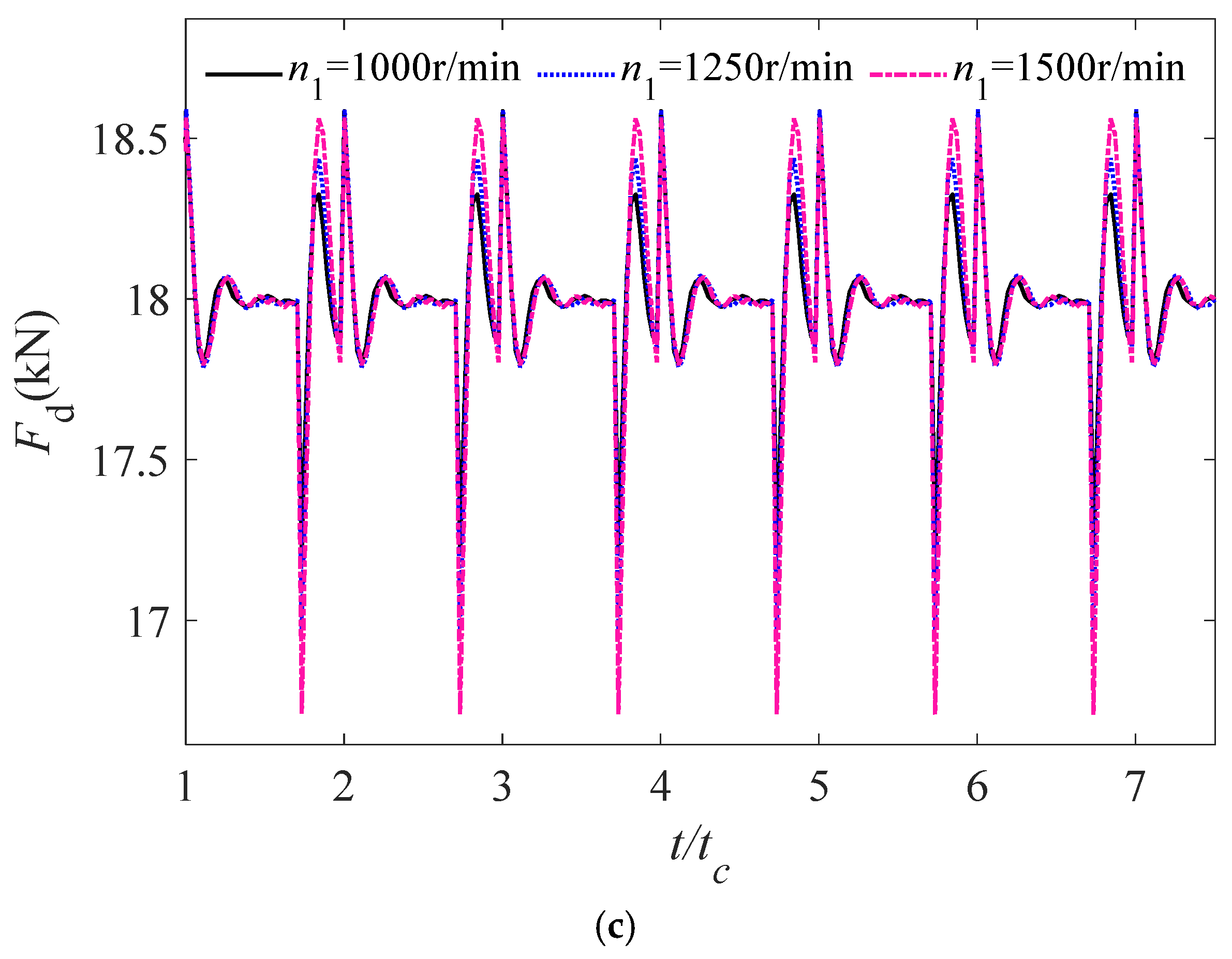
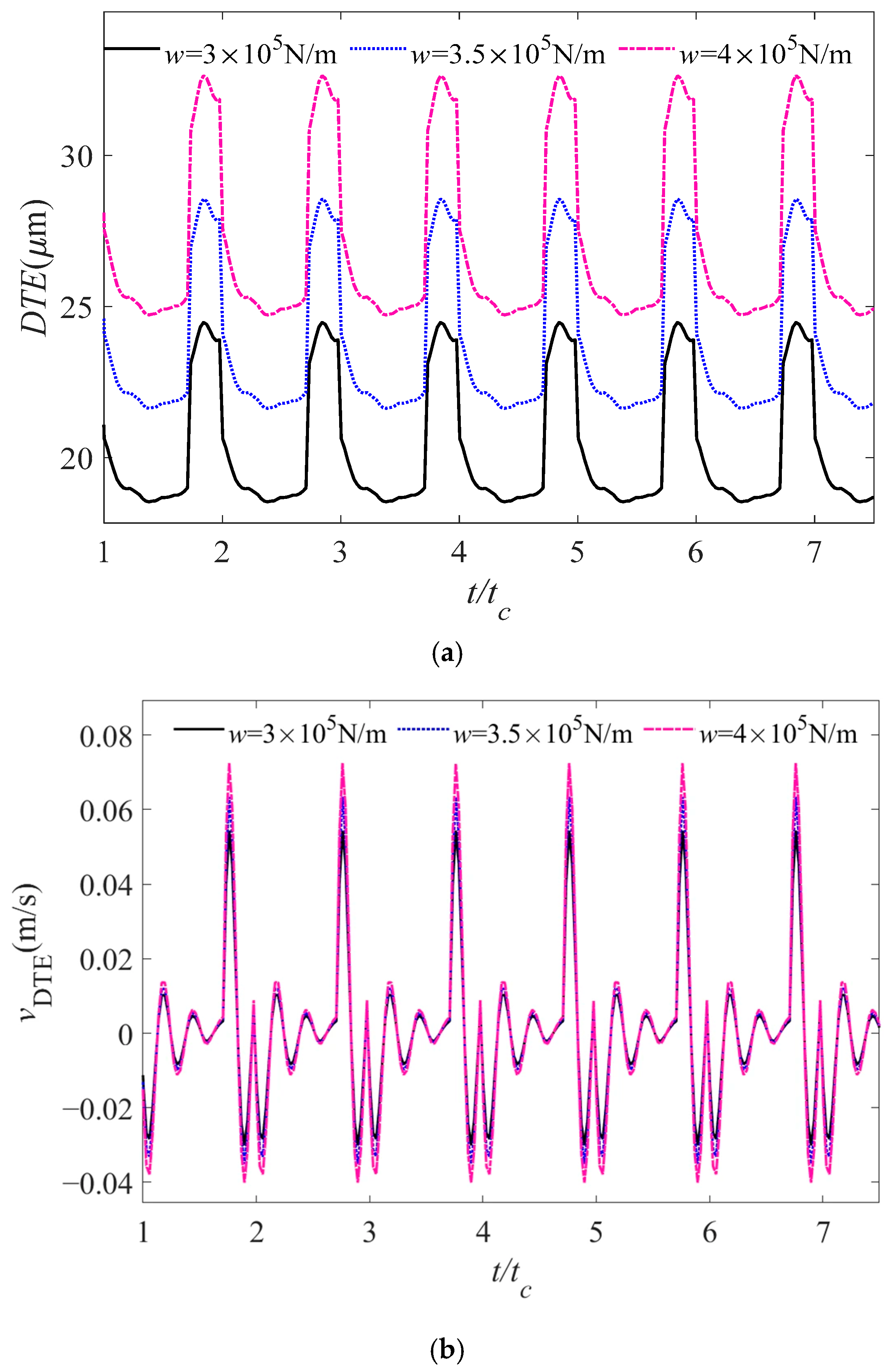
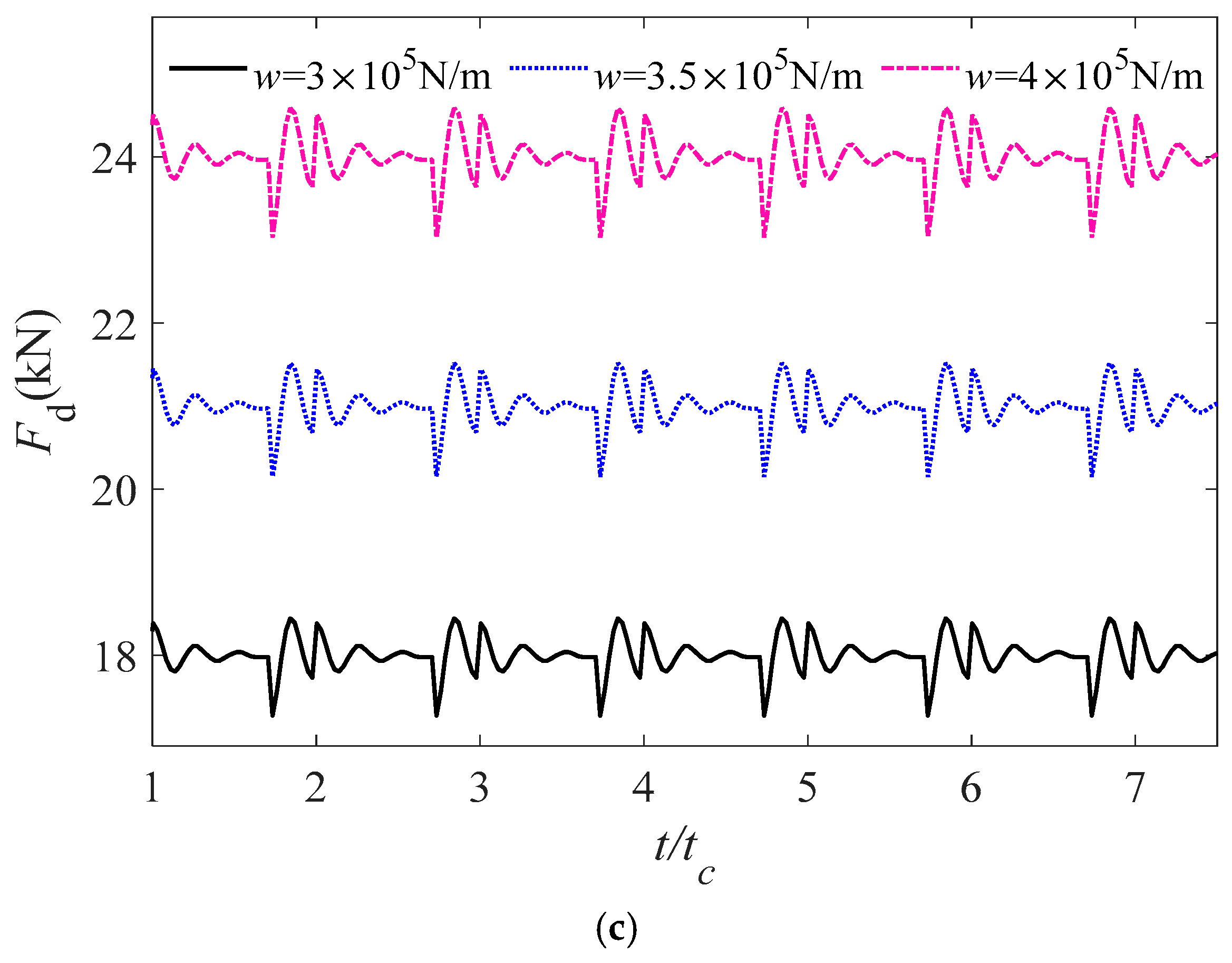
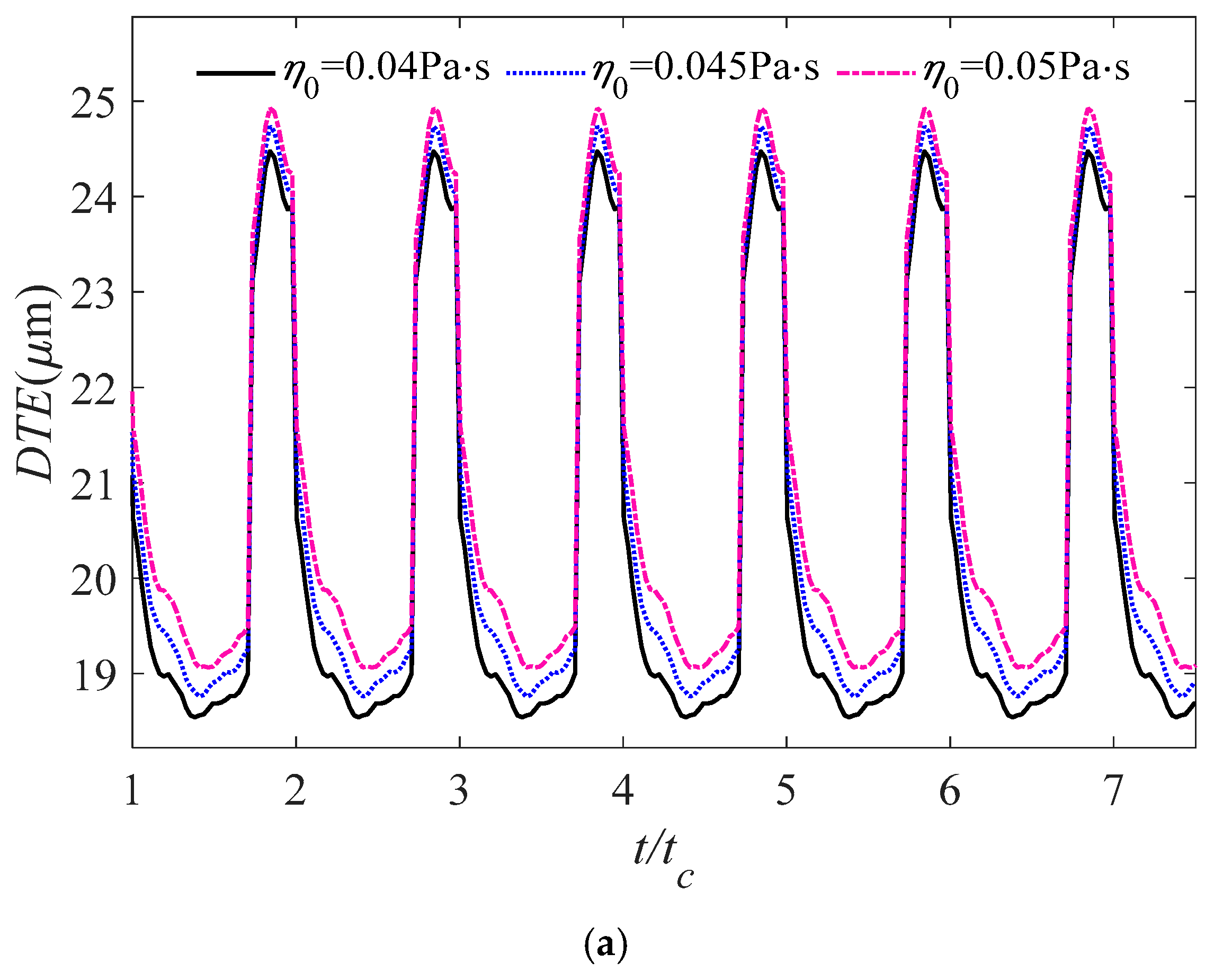
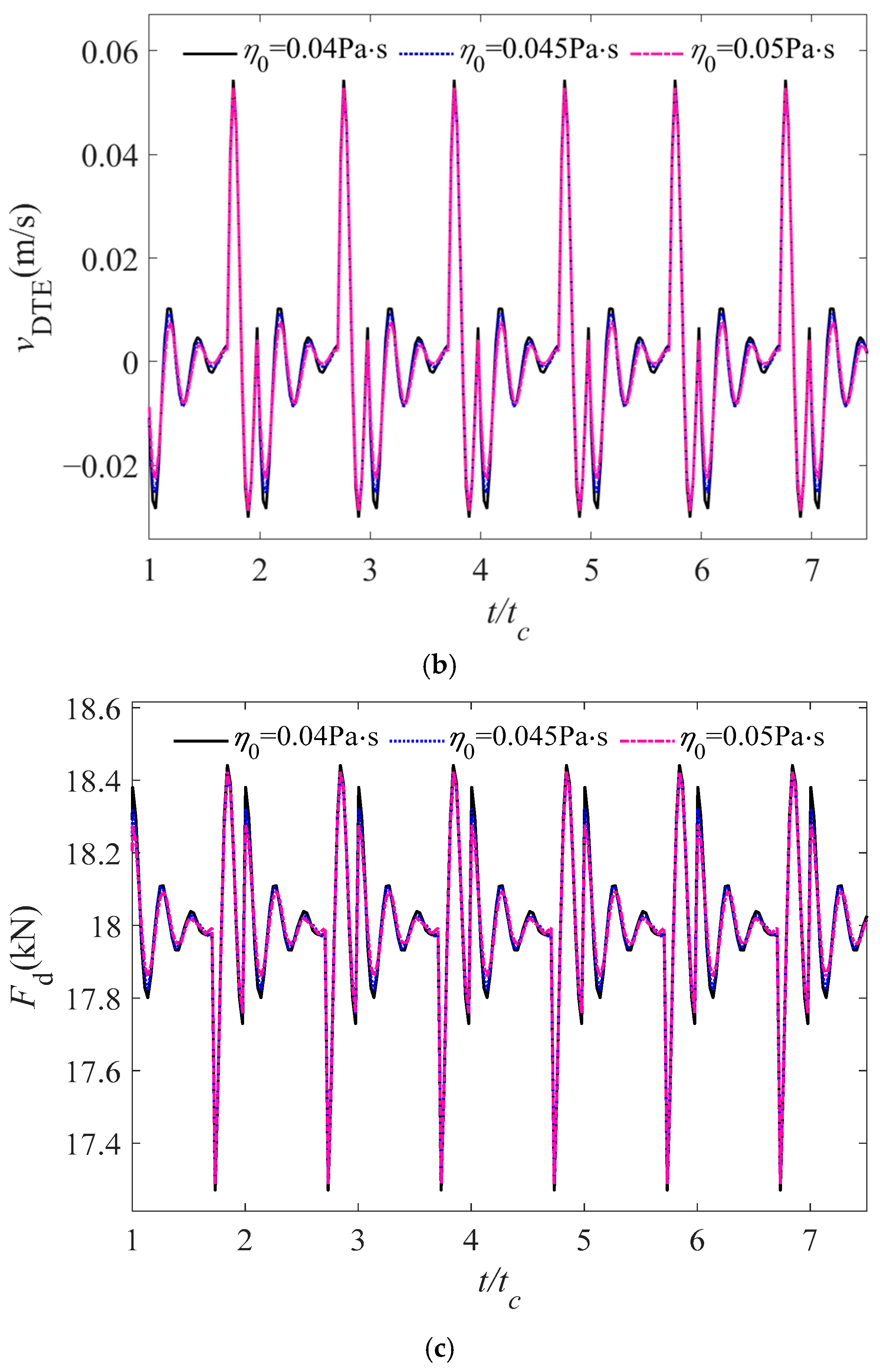
| Parameter | Symbols | Value |
|---|---|---|
| Number of gear teeth | z1, z2 | 31.65 |
| Gear module | m | 4.5 × 10−3 m |
| Gear width | B | 0.06 m |
| Pressure angle | αn | 20° |
| Gear material density | ρ1, ρ2 | 7850 kg·m−3 |
| Gear material Poisson’s ratio | ν1, ν2 | 0.3 |
| Gear material elastic modulus | E1, E2 | 2.1 × 1011 Pa |
| Lubricant ambient density | ρ0 | 870 kg·m−3 |
| Density-temperature coefficient | D | −0.00065 K−1 |
| Specific heat capacity of fluid | cp | 2000 J·kg·K−1 |
| Thermal conductivity of fluid | k | 0.14 W·m−1·K−1 |
| Specific heat capacity of gear material | c1/c2 | 46 J·kg·K−1 |
| Thermal conductivity of gear material | k1/k2 | 470 W·m−1·K−1 |
| Ambient temperature | T0 | 303 K |
| Parameter | Symbols | Value |
|---|---|---|
| mass of the pinion | m1 | 6.158 kg |
| mass of the gear | m2 | 27.707 kg |
| moment of inertia of the pinion | I1 | 0.01666 kg·m2 |
| moment of inertia of the gear | I2 | 0.32867 kg·m2 |
| Bearing radial stiffness | kr | 6.65 × 107 N/m |
| Bearing damping coefficient | cr | 1.8 × 105 N·s/m |
| DTE | Vibration Velocity | Dynamic Meshing Force | |
|---|---|---|---|
| Unlubricated fluctuation amplitude | 7.516 μm | 0.120 m/s | 1.796 kN |
| Lubricated fluctuation amplitude | 5.934 μm | 0.084 m/s | 1.169 kN |
| Amplitude change rate | −21.05% | −29.66% | −34.92% |
Disclaimer/Publisher’s Note: The statements, opinions and data contained in all publications are solely those of the individual author(s) and contributor(s) and not of MDPI and/or the editor(s). MDPI and/or the editor(s) disclaim responsibility for any injury to people or property resulting from any ideas, methods, instructions or products referred to in the content. |
© 2025 by the authors. Licensee MDPI, Basel, Switzerland. This article is an open access article distributed under the terms and conditions of the Creative Commons Attribution (CC BY) license (https://creativecommons.org/licenses/by/4.0/).
Share and Cite
He, Z.; Wang, X.; Li, Y.; Yang, Y. Analysis of Gear System Dynamics Based on Thermal Elastohydrodynamic Lubrication Effects. Lubricants 2025, 13, 411. https://doi.org/10.3390/lubricants13090411
He Z, Wang X, Li Y, Yang Y. Analysis of Gear System Dynamics Based on Thermal Elastohydrodynamic Lubrication Effects. Lubricants. 2025; 13(9):411. https://doi.org/10.3390/lubricants13090411
Chicago/Turabian StyleHe, Zhaoxia, Xiangjun Wang, Yinan Li, and Yunfei Yang. 2025. "Analysis of Gear System Dynamics Based on Thermal Elastohydrodynamic Lubrication Effects" Lubricants 13, no. 9: 411. https://doi.org/10.3390/lubricants13090411
APA StyleHe, Z., Wang, X., Li, Y., & Yang, Y. (2025). Analysis of Gear System Dynamics Based on Thermal Elastohydrodynamic Lubrication Effects. Lubricants, 13(9), 411. https://doi.org/10.3390/lubricants13090411




